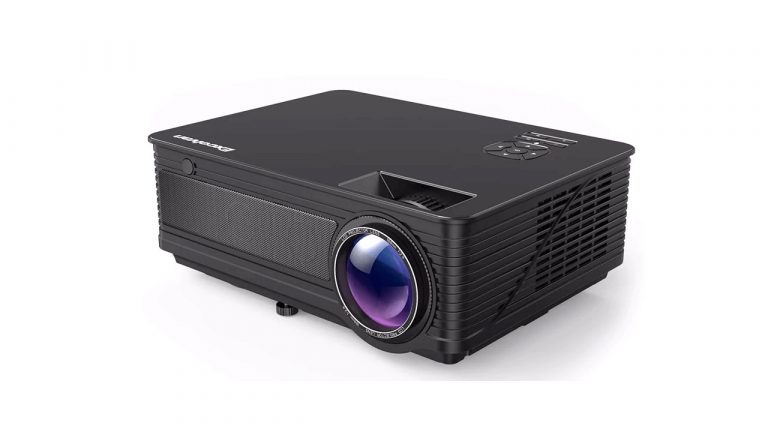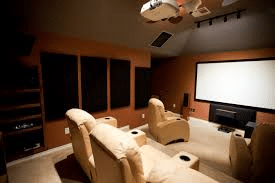Buying a projector is a sizable investment. This is why they are designed to last for a long time. Eventually, though, your projector will need to be replaced. When it comes time to purchase a new projector, there are at least five things that we recommend you consider.
Contents
1. The Right Throw Ratio for Your Desired Image Size
Do you have a specific place in mind where you want to mount your projector? Understanding the throw ratio will help you purchase a projector that is right for the space you are using and the distance you want to have the projector from the screen or wall the projected image will be displayed on.
The first thing to do is determine how big you want the image size to be. This may be the size of the screen you have purchased, the size of a wall, or the size of an area that you have framed off and prepared on your wall for projection. For the sake of argument, we are going to say that the size is 2.1 m.
How far back will the projector sit from the surface where the image will be projected? For the sake of argument, we are going to say 3 m. In order to determine the right throw ratio for your projector, you would take the distance of 3 m, divide it by the size of 2.1 m, and this would bring you to a throw ratio of 1.42. So you may look for a projector that has a throw ratio of 1.15 through 1.5. If you purchase a projector that has a throw ratio of 1.95, for example, the image would not fit on your screen.
2. Spend More for Resolution
Projectors are a lot less expensive now than just a few years ago. You can purchase a 1080P projector for well under $500 USD. If you double that price and spend $1,000 USD, you can find 4K projectors of a similar quality as the $500 1080P projector. There are benefits in spending more money and getting a projector that has a higher resolution.
Over the life of your projector, the resolution of the media that is being produced is only going to improve. 4K media is becoming more common. Over the next five years, it will be as common as 1080P with 8K nipping at its heels. It is worth it to spend more money to get a higher resolution projector since it is going to allow you to enjoy good content throughout your life.
In our scenario, if you purchase the 4K projector for $500 more, over the five-year life span of the projector, you are only paying an additional $16 a month to have a high-quality home theater. Conversely, if you go with the cheaper model that supports a resolution that will shortly be phased out, you may find yourself purchasing a new projector in a couple of years anyway.
3. Make Sure the Projector Is Bright Enough
The brightness of the image your projector produces is measured in ANSI lumens. This is the standard that has been established by the American National Standards Institute. This standard is based on a number of measurements that are taken from different positions.
You may see a projector that is advertised as having 4,000 lm. However, in reality, it has less than 1,000 lm. This is because the brand is not using ANSI standards. It is important to look at how the projector is counting lumens when differentiating between the brightness of two projectors. For our money, it is best to stick with name brand projectors as they have all agreed to use the ANSI standard.
In most scenarios, between 2,600 lm and 3,500 lm will be enough. This will allow you to enjoy movies or other projected images in a completely dark room without being blinded by the projector’s light while at the same time seeing clear images during the day when there is ambient light.
4. Connectivity
Projectors have come with VGA ports for as long as they have been around. VGA is a form of connection that is slowly being phased out. You will notice that most newer laptops do not have a VGA connection.
If you are using your projector in the business world, you will want a USB port that can handle a flash drive. This is a great way to carry out a business presentation. If you are using your projector for gaming or if you want to connect to most forms of media, an HDMI port is a must. While only one port is required, it is beneficial to have two or more ports on a projector as this will allow you to connect multiple sources simultaneously.
An ethernet port is a good option for a fixed projector because it makes it possible to operate the projector online. A fixed ethernet connection can be more reliable than Wi-Fi. A projector with Wi-Fi support is useful as it allows you to stream from a host of modern devices.
5. Indoor or Outdoor?
A common mistake that people make when purchasing a projector is thinking that a projector that is designed for indoor use will work just as well outdoors. Outdoor projectors produce a better overall quality because they are designed to compensate for the things that you can’t control, such as ambient light. Outdoor projectors will have a higher resolution and a higher contrast ratio.
Operating an outdoor projector indoors may be problematic because outdoor projectors usually have a more powerful cooling system. The fan produces a higher decibel level that will not be noticeable outdoors but can become a major source of distraction inside of a small room.
There you have it. These are the five things we feel you should consider when determining which projector is going to be right for you. In addition to these five points, you should think about things like the peripheral items you will use, such as a screen, sound system, and other preparations for the display area.
What do you think are other important factors to consider before purchasing a projector? We would love to hear from you. Reach out to us in the comments section below.


